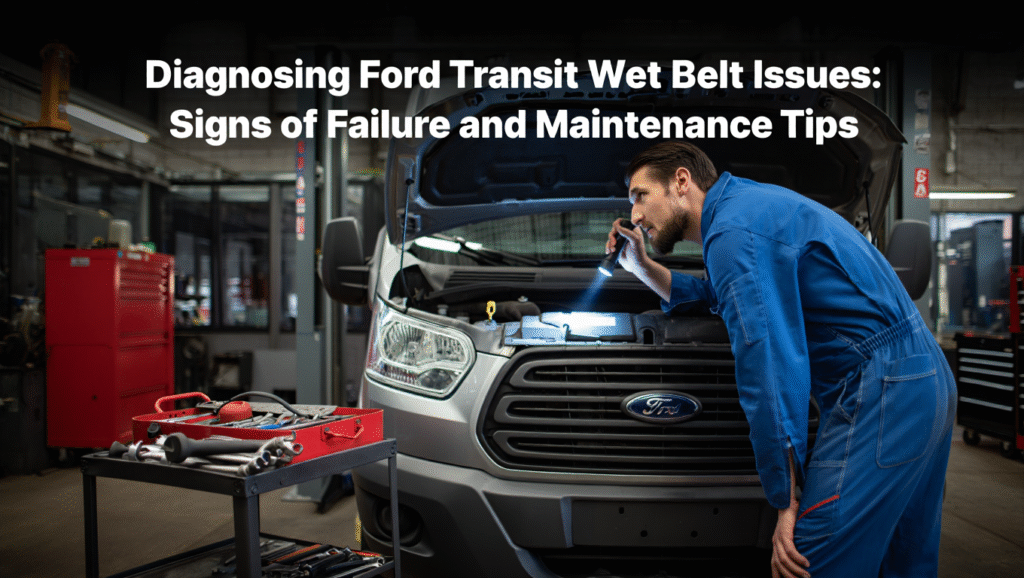
If you own a Ford Transit, you might have heard about wet belt problems. These issues can cause headaches if not spotted early. In this guide, we’ll walk through everything you need to know about Ford Transit wet belt issues, from spotting the warning signs to keeping your van running smoothly.
Understanding Ford Transit Wet Belt Issues
Wet Belt vs Timing Belt
First things first, what exactly is a wet belt? Unlike a traditional timing belt that runs dry outside the engine, a wet belt operates inside the engine and is constantly exposed to oil. Ford introduced this design in their EcoBoost engines, including those in Transit vans.
The main difference is that understanding the differences between wet belts and timing belts comes down to their location and environment. Wet belts in oil require different maintenance than regular timing belts. They typically last longer because the oil lubricates them, but when they do fail, the problems can be more serious.
Common Wet Belt Failures
Ford Transits, particularly models with EcoBoost engines, sometimes run into wet belt problems. Common issues with Ford Transit wet timing belts include:
- Belt material breaking down due to oil contamination
- Tensioner failures causing belt misalignment
- Guide pulley wear leading to belt damage
- Oil seal leaks affecting belt performance
These issues don’t always give you plenty of warning, which is why knowing the symptoms is so important for Transit owners.
Recognising Signs of a Bad Wet Belt and Wet Belt Failure Symptoms
Detecting Ford Transit Wet Belt Symptoms Early
Catching wet belt failure symptoms early can save you from expensive repairs. Here’s what to watch for:
- Strange noises from the engine (particularly rattling or ticking sounds)
- Misfiring or rough idle
- Loss of power when accelerating
- Oil leaks around the timing cover
- Engine warning light coming on
- Unusual vibrations through the van
Early signs of wet belt failure in Ford EcoBoost engines might seem minor at first, but they shouldn’t be ignored.
Consequences of Ignoring Wet Belt Failure Symptoms
Ignoring signs of a bad wet belt can lead to serious Ford Transit engine problems. When a wet belt fails completely, it can cause:
- Bent valves when timing is lost
- Piston damage from valve contact
- Complete engine failure requiring replacement
- Being stranded at inconvenient times
- Much higher repair bills than preventative maintenance
Consequences of ignoring wet belt failure symptoms can be costly. What might start as a £500-£800 belt replacement job can quickly become a £3,000+ engine rebuild if the belt snaps.
Diagnosing Wet Belt Problems in Ford Transits
Practical Wet Belt Inspection Guide
While a full inspection needs a mechanic, there are some checks you can do yourself:
- Check for oil leaks around the timing cover
- Listen for unusual engine noises, especially on startup
- Keep track of your mileage and service history
- Watch for performance changes or warning lights
- Look for oil contamination or deterioration
For a more detailed look, practical guide for inspecting wet belts can help you understand what mechanics check when servicing your Transit.
When to Seek Professional Help
Sometimes it’s best to leave it to the experts. Consider professional help if:
- Your van has reached the recommended belt change interval (usually 125,000 miles)
- You notice any of the warning signs mentioned earlier
- Your Transit is approaching 5-7 years old (age affects belts too)
- You’ve bought a used Transit with unknown service history
- Your engine light is on with timing-related fault codes
When to seek professional help for wet belt issues will depend on your van’s age and condition, but it’s always better to be safe than sorry with wet belt concerns.
Conquering Ford Transit Engine Problems: Wet Belt Replacement and Maintenance Tips
Navigating Wet Belt Replacement Cost
Let’s talk money. Wet belt replacement cost typically ranges from £500-£850 for a Ford Transit. This includes:
- The belt itself
- New tensioners and pulleys
- Water pump (often replaced at the same time)
- Labour (which is significant as the engine needs partial disassembly)
While this might seem expensive, navigating wet belt replacement costs shows it’s much cheaper than the alternative of engine failure. Consider it an investment in your van’s future.
Ford Transit Maintenance Tips
Good maintenance can extend your wet belt’s life:
- Follow Ford’s recommended service intervals
- Use the correct oil grade for your engine
- Address oil leaks promptly to prevent contamination
- Consider early belt replacement if you use your van for heavy work
- Keep an eye on cooling system health (overheating affects belts)
These Ford Transit maintenance tips to prevent wet belt failures can help you keep your van running smoothly and avoid unexpected breakdowns.
The Role of a Trusted Recovery Service in Troubleshooting Ford Transit Wet Belt Issues
Why Choose Reds Recovery Services for Your Ford Transit Concerns
Even with the best maintenance, sometimes things go wrong. That’s where we come in. At Reds Recovery Services, we understand Ford Transit wet belt issues and can help when you’re stuck.
We offer:
- Fast response times across the UK
- Experienced technicians who know Transits
- 24/7 availability for when problems happen at the worst times
- Reliable transport of your van to your preferred garage
The Assurance of Reds Recovery Services: We’ve Got Your Back
Our 7.5 tonne flatbed recovery truck can safely transport your Ford Transit wherever it needs to go. We’ve helped countless Transit owners who’ve experienced wet belt failures, getting them and their vans to safety quickly.
Whether it’s a complete breakdown or you’ve spotted warning signs and want to get your van to a garage before things get worse, we’re here to help with professional, friendly service.
Final Thoughts
Ford Transit wet belt issues don’t have to mean disaster for your van or your wallet. By knowing the signs, maintaining your vehicle properly, and having a reliable recovery service on speed dial, you can manage the risks and keep your Transit running for years to come.
Remember that prevention is always better (and cheaper) than cure when it comes to wet belt problems. Keep an eye on your van, listen to what it’s telling you, and don’t ignore those early warning signs.
If you’re experiencing Ford Transit wet belt issues, trust Reds Recovery Services for reliable vehicle recovery and expert guidance, available 24/7 across the UK. Reach out to us today and let us help make your journey safe and smooth.
